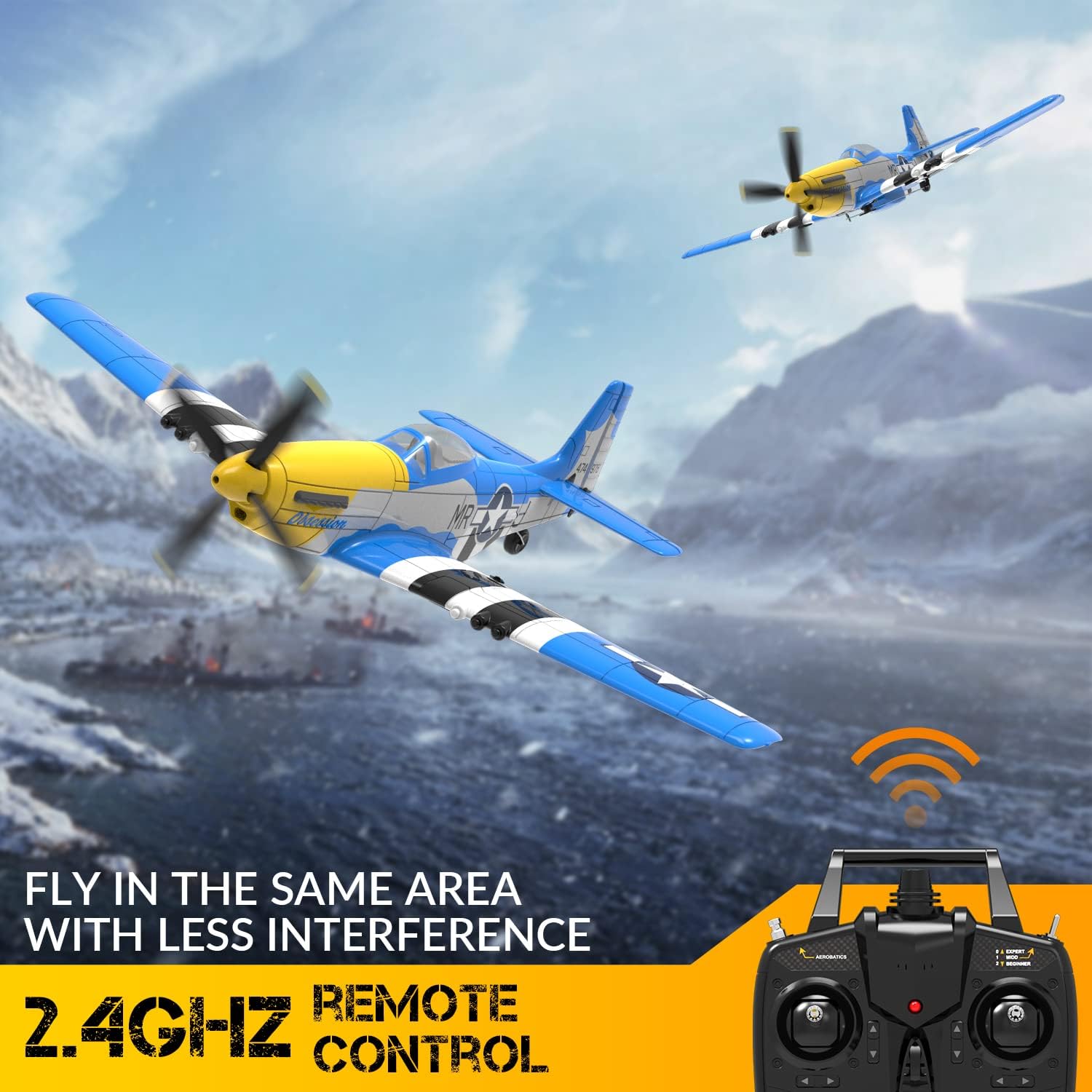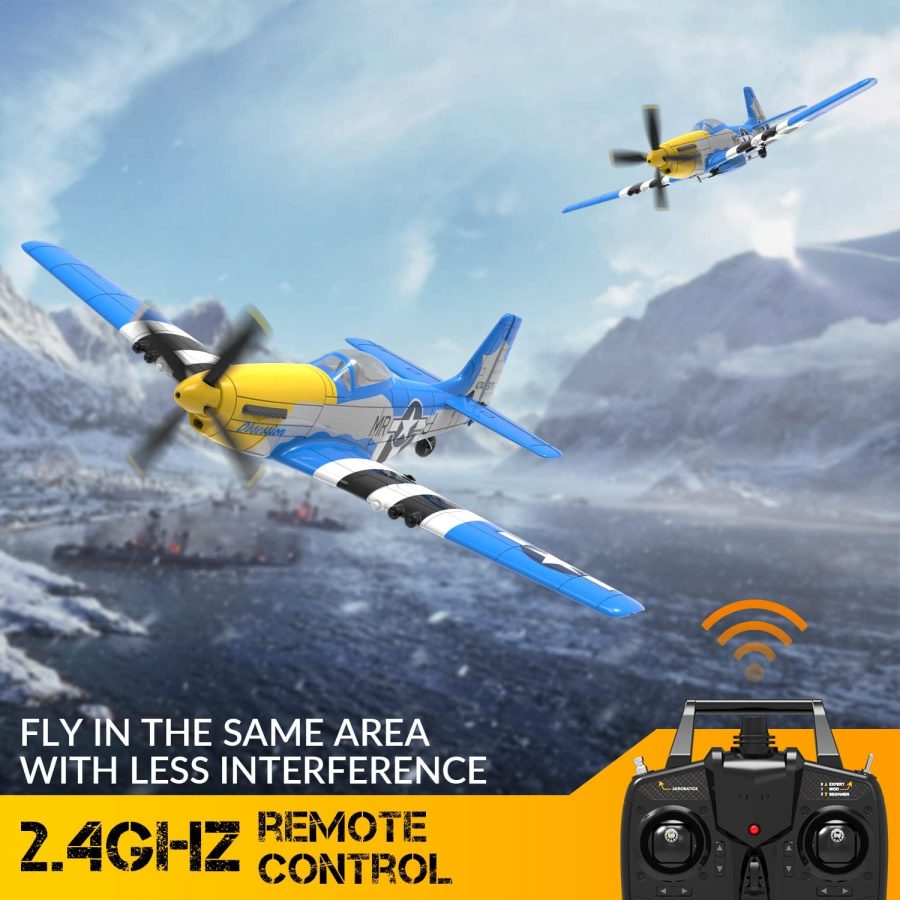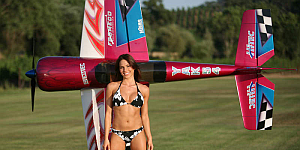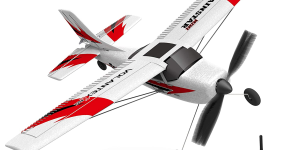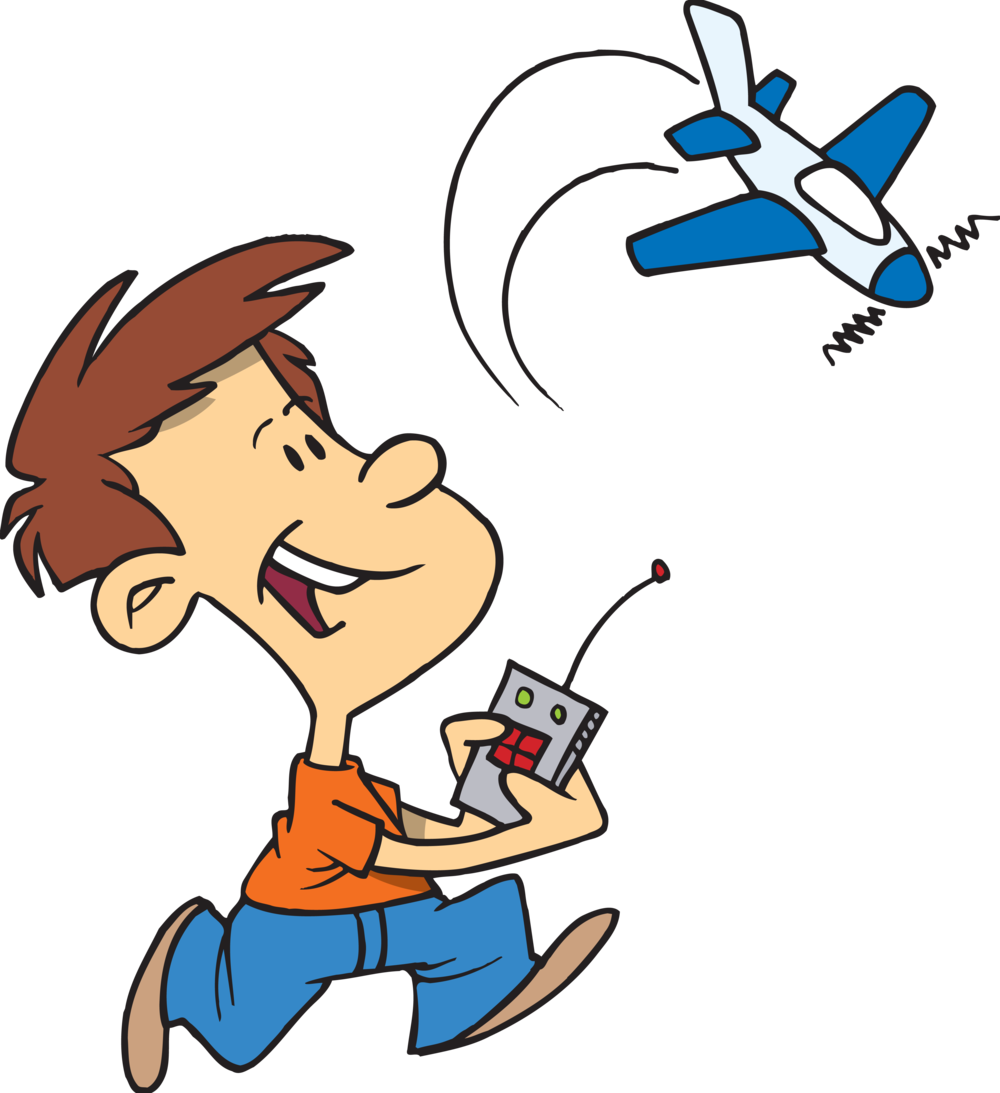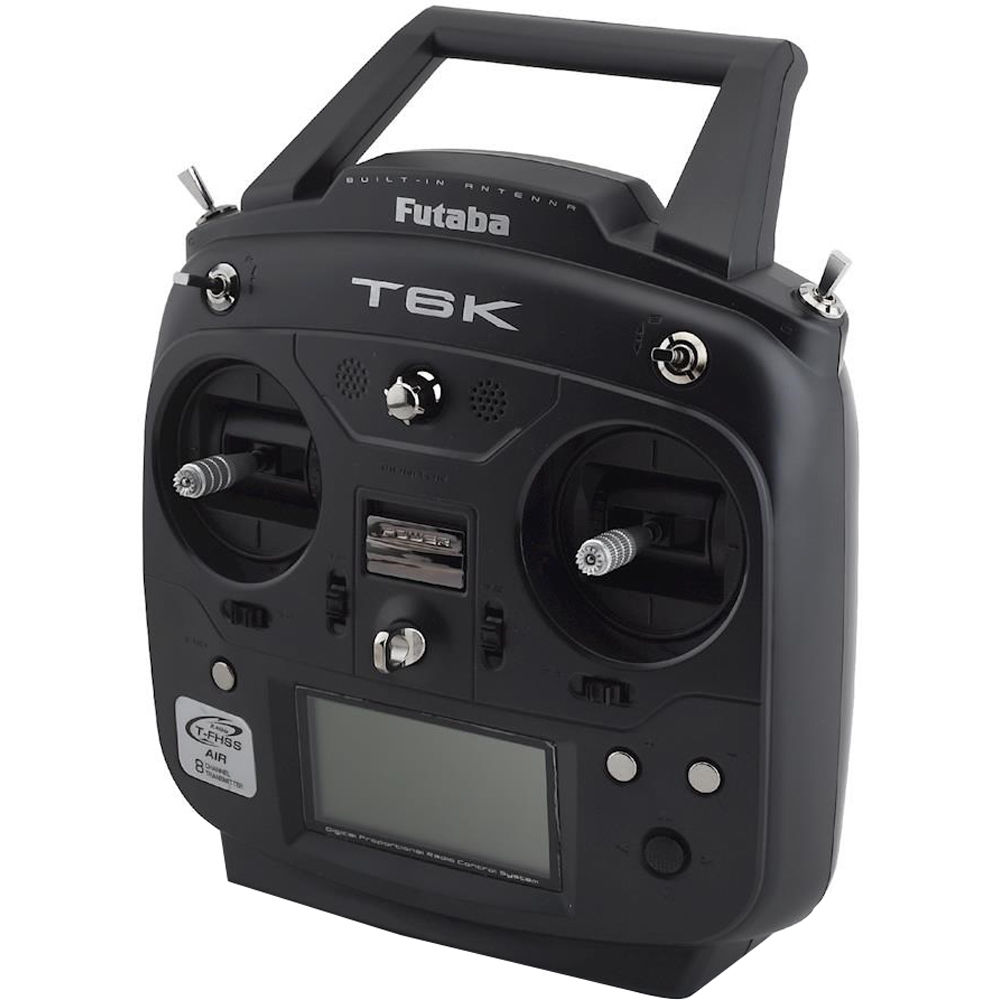Welcome to the exhilarating world of RC aviation! If you’re seeking the thrill of piloting, look no further than the VOLANTEXRC P-51D Mustang. This guide will unlock the secrets to mastering this remarkable aircraft, ensuring every flight is a memorable adventure. Whether you’re a novice or an experienced pilot, prepare for a journey that promises maximum fun and satisfaction. Let’s take to the skies!
In this comprehensive guide, we’ll explore everything you need to know about the VOLANTEXRC P-51D Mustang. From understanding its unique features to mastering the controls, from your first flight to advanced flying techniques, we’ve got you covered. We’ll also share essential maintenance tips to ensure your Mustang stays in top shape for those thrilling flights.
But why should you trust us? Well, we’re not just writers; we’re passionate RC plane experts with years of experience in the field. We’ve flown countless P-51 Mustang RC models, and we’re here to share our knowledge and insights with you. So, buckle up and get ready for an exciting journey into the world of the VOLANTEXRC P-51D Mustang.
By the end of this guide, you’ll be well-equipped to take to the skies with confidence and have maximum fun with your Mustang. Let’s get started!
VOLANTEXRC P-51D Mustang Overview
Contents
- VOLANTEXRC P-51D Mustang Overview
- Understanding the VOLANTEXRC P-51D Mustang Features
- Setting Up the VOLANTEXRC P-51D Mustang
- Getting Ready for Takeoff
- Mastering the Controls
- First Flight with the VOLANTEXRC P-51D Mustang
- Beginner Tips to Flying VOLANTEXRC P-51D Mustang
- Advanced Flying Techniques
- Expert Tips to Flying VOLANTEXRC P-51D Mustang
- Key Points to Remember When Flying the VOLANTEXRC P-51D Mustang
- Common Mistakes to Avoid When Flying the VOLANTEXRC P-51D Mustang
- Maintaining Your VOLANTEXRC P-51D Mustang
- Why Trust Us
- FAQs
- What makes the VOLANTEXRC P-51D Mustang special?
- What are the flight modes available on the VOLANTEXRC P-51D Mustang?
- What is the One-Touch Takeoff feature?
- What is the One Key Return feature?
- How long does the battery last?
- How do I know if the aircraft is out of signal range or if the battery is low?
- Can the VOLANTEXRC P-51D Mustang be flown with multi-protocol transmitters?
- What is the weight of the VOLANTEXRC P-51D Mustang?
- What is the Quick Disconnect Propeller Saver?
- Conclusion
The VOLANTEXRC P-51D Mustang is a remarkable piece of engineering that brings the thrill of flying a warbird right into your hands. This RC plane is a replica of the P-51 Mustang, the most famous fighter of the U.S. Army Air Corps during World War II. It’s not just the historical significance that makes this plane special, but also its design, features, and performance.
The VOLANTEXRC P-51D Mustang comes pre-assembled and ready to fly (RTF), meaning you can start your flying adventure within minutes of unpacking. This feature sets it apart from many other RC planes that require time-consuming assembly and setup. It’s perfect for those who want to get started quickly and enjoy the fun of flying without the hassle of assembly.
One of the standout features of this plane is its one-touch takeoff. This function allows the plane to automatically take off to the proper altitude and hover in a certain area, making it easier for beginners to get started. The plane also comes with a signal loss alarm and a low battery alarm, ensuring a safe and enjoyable flying experience.
The VOLANTEXRC P-51D Mustang is constructed of flexible and crash-resistant EPP foam, which adds to its durability. It’s powered by a 1020 brushed motor that provides plenty of power for flight. The plane comes with two 2-bladed and two 4-bladed propellers. The 4-bladed propellers are best used for display, while the 2-bladed propellers provide ample power for flight purposes.
This RC plane also offers three selectable flight modes: Beginner mode with full 6-axis stabilization and angle restrictions, Intermediate mode with 6-axis stabilization but without pitch angle restrictions for aerobatic stunts, and Expert mode for fully aerobatic manual flying. This makes the VOLANTEXRC P-51D Mustang suitable for both novice and experienced pilots.
The VOLANTEXRC P-51D Mustang is not just an RC plane; it’s a piece of history that you can control. Whether you’re a beginner looking to get into the hobby or an experienced pilot looking for a new challenge, this plane offers an exciting and rewarding flying experience.
Understanding the VOLANTEXRC P-51D Mustang Features
The VOLANTEXRC P-51D Mustang is a marvel of design and engineering, packed with features that make it a standout in the world of RC planes. This model is not just a replica of the iconic P-51D Mustang, but it’s also a high-performance RC plane that offers an immersive flying experience.
One of the most notable features of the VOLANTEXRC P-51D Mustang is its 6-Axis Gyro System. This advanced stabilization system makes the plane incredibly stable in flight, reducing the chances of crashes and making it easier for beginners to learn to fly. The gyro system can be adjusted to three levels – beginner, mid-level, and expert, allowing pilots to choose the level of assistance they need based on their skill level.
The One-Key Aerobatic feature is another highlight that sets the VOLANTEXRC P-51D Mustang apart. This feature allows pilots to perform impressive aerobatic maneuvers like loops and rolls with just a single button press, adding an extra layer of excitement to the flying experience.
The VOLANTEXRC P-51D Mustang also boasts a Powerful Brushless Motor. This motor provides the plane with plenty of power, allowing it to reach impressive speeds and perform advanced maneuvers. Despite its power, the motor operates quietly, ensuring a peaceful flying experience.
The plane’s Durable EPO Material construction is another feature worth mentioning. This material is known for its durability and resilience, making the plane resistant to crashes and ensuring it can withstand the rigors of regular use.
The VOLANTEXRC P-51D Mustang also comes with a 2.4Ghz Radio Control System, which ensures a stable connection with a long control range, allowing pilots to fly the plane over long distances without losing control.
Lastly, the plane’s Quick Assembly Design makes it easy to put together and get flying. Most of the main parts, including the wing and tail, are pre-assembled, so you can have your plane ready to fly in no time.
In summary, the VOLANTEXRC P-51D Mustang is packed with features designed to enhance the flying experience. Whether you’re a beginner looking for a plane that’s easy to fly or an experienced pilot seeking a model capable of advanced maneuvers, the VOLANTEXRC P-51D Mustang has you covered.
Setting Up the VOLANTEXRC P-51D Mustang
Before you can take to the skies with your VOLANTEXRC P-51D Mustang, it’s crucial to set it up correctly. This process is straightforward and designed to get you flying in no time.
- Unboxing: The first step is to carefully unbox your new plane. The VOLANTEXRC P-51D Mustang comes fully assembled, so you don’t need to worry about complex assembly instructions.
- Inspect the Plane: Before you start flying, it’s a good idea to inspect the plane. Check the propeller, wings, and body for any damage that might have occurred during shipping. The plane is made of durable EPP foam and reinforced with carbon fiber rods, making it sturdy and resilient.
- Charge the Battery: The plane comes with a rechargeable battery. Make sure to charge it fully before your first flight. A fully charged battery will give you more flight time, allowing you to enjoy the experience for longer.
- Install the Battery: Once the battery is fully charged, install it in the plane. Make sure it’s securely in place before you close the battery compartment.
- Check the Controls: The VOLANTEXRC P-51D Mustang comes with a 2.4GHz FHSS remote control. Before you take off, familiarize yourself with the controls. Test the throttle, rudder, and elevator controls to ensure they’re working correctly.
- Test Flight: Before you take your plane out for its maiden flight, it’s a good idea to do a test flight. This will help you get a feel for the controls and how the plane handles.
Remember, the VOLANTEXRC P-51D Mustang is equipped with a 6-axis gyro with Xpilot stabilization system, making it easier to fly, even for beginners. It also has a one-key U-turn function, which allows the plane to return automatically, reducing the chances of losing your plane.
Setting up your VOLANTEXRC P-51D Mustang is a straightforward process, designed to get you in the air as quickly as possible. By following these steps, you’ll be ready for takeoff in no time. Happy flying!
Getting Ready for Takeoff
Before you can experience the thrill of guiding your VOLANTEXRC P-51D Mustang through the open skies, there are a few crucial steps to take to ensure a successful takeoff. These steps not only guarantee a smooth flight but also help to protect your RC plane from potential damage.
Check the Weather
Firstly, always check the weather conditions. The VOLANTEXRC P-51D Mustang is a sturdy aircraft, but it performs best in calm weather. Avoid flying in high winds, rain, or snow. Ideal conditions are a clear sky with a light breeze.
Inspect Your Aircraft
Next, conduct a thorough pre-flight inspection. Check the propeller for any signs of damage. Ensure that the wings are securely attached and that the control surfaces, such as the ailerons, rudder, and elevator, move freely and correctly.
Check the Battery
Ensure that your battery is fully charged. The VOLANTEXRC P-51D Mustang uses a 7.4V 500mAh LiPo battery, which provides about 20 minutes of flight time when fully charged. Always have a spare battery on hand for extended flying sessions.
Test the Controls
Before takeoff, it’s crucial to test the controls. With the plane on the ground, move the control sticks on the transmitter and watch to see if the plane’s control surfaces respond correctly. This includes checking the throttle, elevator, rudder, and ailerons.
Choose a Suitable Takeoff Spot
Choose a wide, open space for takeoff, away from trees, buildings, and people. A grassy field is ideal. The VOLANTEXRC P-51D Mustang is equipped with a landing gear suitable for takeoffs and landings on grass or on a runway.
Position the Plane Into the Wind
For the actual takeoff, position your plane facing into the wind. This helps the aircraft lift off the ground more easily and climb steadily.
Remember, preparation is key to a successful flight. By following these steps, you’ll be well on your way to a thrilling flight experience with your VOLANTEXRC P-51D Mustang. In the next section, we’ll delve into mastering the controls of your RC plane, setting you up for an exciting and fun-filled flight.
Mastering the Controls
The VOLANTEXRC P-51D Mustang is a marvel of RC aircraft engineering, designed to provide an immersive flying experience that is both enjoyable and educational. Mastering the controls of this aircraft is a rewarding journey that will enhance your skills as an RC pilot.
The Mustang is equipped with a 2.4GHz FHSS RC technology, which allows more than 20 aircraft to fly simultaneously without interference. This technology also extends the flying range up to 656 feet, providing ample space for you to maneuver and explore the capabilities of the aircraft.
One of the key features of the Mustang is its 6-axis gyro with Xpilot automatic stabilization system. This system provides a stable flying experience, making it easier for beginners to control the aircraft. Even in windy conditions, the Xpilot system ensures that the aircraft remains stable and responsive to your commands.
The Mustang is also equipped with a 4-channel control system, which adds to the playability of the aircraft. This system allows you to perform a variety of stunts with ease. One of the most exciting features is the one-key U-turn function, which enables the aircraft to return automatically. This feature is particularly useful for beginners, as it reduces the risk of losing the aircraft.
The controls of the Mustang are designed to be intuitive and responsive. The throttle stick controls the power to the motor, which in turn determines the speed of the aircraft. The rudder stick controls the yaw of the aircraft, allowing you to steer it left or right. The elevator stick controls the pitch of the aircraft, enabling you to make it climb or descend. Lastly, the aileron stick controls the roll of the aircraft, allowing you to make it roll left or right.
Mastering the controls of the Mustang requires practice and patience. Start by practicing in a large open space with no obstacles. Gradually increase the complexity of your maneuvers as you become more comfortable with the controls. Remember, the key to mastering the controls is to remain calm and composed, even when the aircraft is not responding as expected.
In conclusion, the VOLANTEXRC P-51D Mustang is a fantastic RC aircraft that offers a rewarding flying experience. Its advanced control system, coupled with the Xpilot stabilization system, makes it a great choice for both beginners and experienced pilots. So take the controls, and embark on an exciting journey of RC flying with the Mustang.
First Flight with the VOLANTEXRC P-51D Mustang
The first flight with your VOLANTEXRC P-51D Mustang is an exhilarating experience that you’ll remember for a long time. This RC plane, with its robust construction and advanced features, is designed to make your maiden flight as smooth and enjoyable as possible. Here’s a step-by-step guide to help you navigate this exciting journey.
Pre-Flight Checks
Before you take to the skies, it’s crucial to perform a few pre-flight checks. Ensure that your Mustang’s battery is fully charged and securely fitted. Check the control surfaces for proper movement. The ailerons, elevator, and rudder should respond accurately to your transmitter’s inputs.
Choosing the Right Environment
For your first flight, choose a wide, open space free of obstacles. A large grassy field is ideal. Avoid flying near people, buildings, trees, or bodies of water. The more space you have, the safer and more enjoyable your flight will be.
Takeoff
With the VOLANTEXRC P-51D Mustang, taking off is a breeze. Position the plane into the wind and gradually increase the throttle. As the plane gains speed, gently pull back on the elevator control. The Mustang will gracefully lift off the ground and climb into the sky.
Flying
Once airborne, start with simple maneuvers. Practice climbing, descending, and turning. The Mustang’s 6-axis gyro system provides excellent stability, making it easier to control. Remember to keep the plane within your line of sight at all times.
Landing
When it’s time to land, reduce your altitude gradually while approaching your landing spot. Cut the throttle as the plane nears the ground, and let it glide smoothly to a stop. Remember, practice makes perfect. Don’t be discouraged if your first few landings are a bit rough.
Safety Tips
Always turn on the transmitter before powering up the plane, and do the reverse when shutting down. This prevents the plane from receiving stray signals that could cause it to operate unexpectedly.
Remember, the key to a successful first flight is to take things slow and steady. Don’t rush into advanced maneuvers until you’re comfortable with the basics. With patience and practice, you’ll soon be flying the VOLANTEXRC P-51D Mustang like a pro.
Beginner Tips to Flying VOLANTEXRC P-51D Mustang
Embarking on your journey as an RC pilot with the VOLANTEXRC P-51D Mustang is an exciting adventure. This plane, with its robust design and advanced features, is a fantastic choice for beginners. Here are some tips to help you get started:
- Understand Your Plane: Before you take to the skies, familiarize yourself with the Mustang’s features and controls. The Mustang comes with a 6-axis gyro system that makes it stable and easy to control, even in windy conditions. It also has a beginner mode that restricts the plane’s movements, making it easier for new pilots to control.
- Start with Small Steps: Don’t rush into complex maneuvers on your first flight. Start with simple movements. Practice taking off and landing, and get comfortable with basic turns and level flights.
- Choose the Right Environment: For your initial flights, choose a large, open space free of obstacles. Avoid crowded areas and keep a safe distance from people and buildings. The ideal conditions would be a calm day with minimal wind.
- Use the Beginner Mode: The Mustang comes with a beginner mode that’s perfect for those new to RC flying. This mode limits the plane’s movements, making it easier to control. Once you’re comfortable, you can switch to intermediate or expert mode.
- Learn to Land: Landing is one of the trickiest parts of flying, but the Mustang makes it easier with its stabilized system. Practice your landings on a soft surface to minimize potential damage.
- Battery Care: Always monitor your battery levels. The Mustang has a flight time of around 20 minutes. When the battery gets low, it’s time to land. Over-draining the battery can damage it and shorten its lifespan.
- Stay Patient and Positive: Learning to fly an RC plane takes time and practice. Don’t get discouraged if you don’t get it right away. With patience and practice, you’ll soon be soaring the skies with confidence.
Remember, the key to becoming a skilled RC pilot is practice. The more time you spend with your VOLANTEXRC P-51D Mustang, the better you’ll understand its capabilities and how to control it. Happy flying!
Advanced Flying Techniques
Once you’ve mastered the basics of flying the VOLANTEXRC P-51D Mustang, you can start to explore some of the more advanced flying techniques. These techniques will not only make your flights more exciting but also help you gain better control over your RC plane.
Aerobatic Stunts
The VOLANTEXRC P-51D Mustang is capable of performing a variety of aerobatic stunts. Here are a few you can try:
- Loops: To perform a loop, you need to gain some speed, then pull back on the stick to raise the nose of the plane. As the plane climbs, continue to pull back until the plane is upside down at the top of the loop. Then, let the plane fall back down, completing the loop.
- Rolls: To perform a roll, you need to gain some altitude and speed. Then, move the stick to the left or right, which will cause the plane to roll along its longitudinal axis.
- Inverted Flight: This is a more advanced maneuver where you fly the plane upside down. To do this, perform a half roll, then adjust the elevator control to maintain altitude.
Remember, always practice these stunts at a safe altitude and away from people and property.
Precision Flying
Precision flying involves flying your RC plane through a predetermined course or pattern with accuracy. This could include flying in a straight line, making precise turns, or navigating around obstacles. Precision flying can help improve your control and understanding of how the plane responds to your inputs.
Formation Flying
If you have fellow RC pilots who also have VOLANTEXRC P-51D Mustangs, you can try formation flying. This involves multiple planes flying together in a coordinated manner. It’s a challenging but rewarding technique that requires good communication and control.
Energy Management
Energy management is an advanced flying technique that involves managing the plane’s potential energy (altitude) and kinetic energy (speed) to perform various maneuvers. Good energy management can help you fly more efficiently and perform smoother maneuvers.
Remember, these advanced techniques require practice and patience. Always fly responsibly and within your skill level.
Expert Tips to Flying VOLANTEXRC P-51D Mustang
The VOLANTEXRC P-51D Mustang is a fantastic RC plane that offers an exhilarating flying experience. However, to truly unlock its potential and maximize your enjoyment, there are some expert tips you should consider:
- Understanding the Plane’s Capabilities: The P-51D Mustang is a versatile aircraft that can handle various flight maneuvers. It’s equipped with a powerful 1020 brushed motor that provides plenty of power for aerobatics. However, remember that it’s a brushed motor airplane, and its motor will eventually fail someday. To improve motor longevity, allow 15 minutes of motor cool down between flights1.
- Mastering the Controls: The P-51D Mustang is a true four-channel airplane with throttle, elevator, rudder, and aileron control1. This gives you a full range of motion and control over the plane. Practice using these controls in different combinations to perform various maneuvers and stunts.
- Using the Xpilot Stabilization System: The P-51D Mustang comes with an Xpilot stabilization system, making it super easy for anyone to fly and enjoy this mini warbird2. This system can be switched to manual flight mode for more aerobatics if you’re a seasoned pilot2.
- Leveraging Flight Modes: The plane offers three selectable flight modes. Beginner mode includes full 6-axis stabilization and angle restrictions that prevent the aircraft from rolling or pitching over. Intermediate mode also includes 6-axis stabilization but turns off pitch angle restrictions to allow aerobatic stunts. Expert mode turns off all stabilization for fully aerobatic manual flying1.
- Performing Aerobatics: The controller includes a stunt button that allows the airplane to automatically conduct loops and aileron rolls1. This feature can be a great way to impress your friends and enjoy the full capabilities of the P-51D Mustang.
- Using the Auto Takeoff Feature: This feature enables the aircraft to automatically climb to a safe altitude, and then circle until the pilot is comfortable and ready to take control of the plane with the pitch/roll stick1. It’s a great way to start your flight with confidence.
- Handling Crashes: The P-51D Mustang is constructed of flexible and crash-resistant EPP foam1. It also features a quick disconnect propeller saver that automatically disconnects the propeller in a crash to prevent propeller or motor damage1. This means you can be a bit more daring with your maneuvers without worrying about damaging your plane.
- Maximizing Flight Time: The plane’s 3.7V 400mah battery provides about 14 minutes of flight time1. To maximize this, try to maintain a steady flight pattern and avoid unnecessary maneuvers.
Remember, the key to becoming an expert pilot is practice. The more you fly the P-51D Mustang, the more familiar you’ll become with its controls and capabilities. So, get out there and enjoy the thrill of flying this amazing RC plane!
Key Points to Remember When Flying the VOLANTEXRC P-51D Mustang
Flying the VOLANTEXRC P-51D Mustang is an exhilarating experience, but it’s essential to keep some key points in mind to ensure a safe and enjoyable flight. Here are the crucial aspects you should pay attention to:
- Pre-flight Checks: Before every flight, make sure to perform a thorough pre-flight check. Ensure that all parts of the plane, including the wings, propeller, and tail, are secure. Check the battery level and ensure it’s fully charged for a complete flight session.
- Understanding the Controls: The VOLANTEXRC P-51D Mustang comes with a 6-axis gyro system that makes it easier to control. Familiarize yourself with the controller, understanding each button’s function, and how it affects the plane’s movement.
- Safe Takeoff and Landing: Always take off and land into the wind. This practice provides better control and reduces the risk of crashes. Remember, smooth and gradual movements are key to a successful takeoff and landing.
- Maintain Line of Sight: Never let the plane get too far away from you. Always maintain a clear line of sight with the plane. This practice ensures you have full control and can react quickly to any potential issues.
- Respect Weather Conditions: The VOLANTEXRC P-51D Mustang performs best in calm weather conditions. Avoid flying in high winds, rain, or snow, as these conditions can make control more challenging and potentially damage the plane.
- Practice Makes Perfect: Don’t be discouraged if you don’t master the controls right away. Flying an RC plane requires practice. Start with simple maneuvers and gradually move on to more complex stunts as you gain confidence.
- Battery Care: To prolong the life of your battery, avoid draining it completely during flights. It’s recommended to stop flying when the battery level reaches around 20%. Also, remember to give the battery time to cool down before charging it.
- Emergency Procedures: Always have a plan for what to do in case of an emergency, such as a sudden loss of control or battery. Knowing how to react in these situations can prevent crashes and damage to the plane.
The key to a successful flight is preparation, understanding, and respect for the plane and the environment in which you’re flying. Keep these points in mind, and you’ll be well on your way to mastering the VOLANTEXRC P-51D Mustang.
Common Mistakes to Avoid When Flying the VOLANTEXRC P-51D Mustang
Flying an RC plane like the VOLANTEXRC P-51D Mustang can be a thrilling experience, but it’s not without its challenges. Here are some common mistakes to avoid to ensure a safe and enjoyable flight:
- Ignoring the Manual: The VOLANTEXRC P-51D Mustang comes with a comprehensive manual that provides crucial information about the plane’s features and operation. Ignoring this manual can lead to mishandling and potential damage to the aircraft. Make sure to read and understand the manual before your first flight.
- Improper Use of One-Touch Takeoff: The Mustang features a one-touch takeoff function, but it’s essential to use it correctly. Ensure the throttle lever is in the zero (bottom) position before pressing the one-touch takeoff button. Pull the throttle lever to the maximum (uppermost position) only when the remote control beeps. If not done correctly, the aircraft may perform an aerobatic function instead of taking off.
- Flying Out of Range: The Mustang’s remote control will sound four consecutive alarms if the plane flies out of signal range or experiences signal interference. Ignoring these alarms can lead to loss of control and potential crashes. Always fly the aircraft within a safe control range.
- Ignoring Low Battery Alarms: The remote control will sound two consecutive alarms when the aircraft’s battery is low. Ignoring these alarms and continuing to fly can lead to a sudden loss of power and a potential crash. Always return the aircraft and replace the flight battery when you hear these alarms.
- Not Allowing Motor Cool Down: The Mustang’s motor is brushed, and it can get hot during flights. It’s recommended to allow a 15-minute cool-down period between flights to improve motor longevity. Ignoring this can lead to premature motor failure.
- Not Using the Correct Propellers for Flight: The Mustang comes with two 2-bladed and two 4-bladed propellers. The 4-bladed propellers are primarily for display and do not provide much power. For flight purposes, always use the 2-bladed propellers.
- Not Practicing Enough: Flying an RC plane requires practice. Don’t expect to perform advanced maneuvers on your first few flights. Start with simple movements and gradually progress to more complex maneuvers as you gain confidence and skill.
Remember, the key to a successful flight is preparation and understanding your aircraft. Avoid these common mistakes, and you’ll be well on your way to mastering the skies with your VOLANTEXRC P-51D Mustang.
Maintaining Your VOLANTEXRC P-51D Mustang
Maintaining your VOLANTEXRC P-51D Mustang is crucial to ensure its longevity and continued performance. Here are some tips to help you keep your RC plane in top shape:
- Regular Inspection: Before and after each flight, make sure to inspect your P-51D Mustang for any signs of damage. Check the propellers, wings, and landing gear for any cracks or breaks. Also, ensure that all screws are tight and secure.
- Battery Care: The life of your RC plane heavily depends on the battery. Always ensure that the battery is fully charged before each flight. Avoid overcharging or completely draining the battery as it can reduce its lifespan. After each flight, allow the battery to cool down before charging it again.
- Cleaning: After each flight, especially if you’re flying in a dusty area, clean your P-51D Mustang. Use a soft brush to remove any dust or debris from the plane. Avoid using water or any liquid cleaners as they can damage the electronic components.
- Storage: When not in use, store your P-51D Mustang in a cool, dry place. Avoid exposing it to extreme temperatures as it can damage the battery and other components. If you’re not going to use the plane for an extended period, remove the battery.
- Propeller Care: The propellers of your P-51D Mustang are crucial for its flight. If you notice any damage or wear on the propellers, replace them immediately. The VOLANTEXRC P-51D Mustang comes with a new propeller protector technology that protects the replaceable propellers from damage.
- Firmware Updates: From time to time, check for any firmware updates for your P-51D Mustang. These updates can improve the performance of your plane and fix any known issues.
Remember, regular maintenance can significantly extend the life of your VOLANTEXRC P-51D Mustang and enhance your flying experience. Happy flying!
Why Trust Us
We’re not just writers or content creators; we’re passionate RC plane enthusiasts with years of experience in the field. Our team is composed of seasoned pilots who have flown a wide variety of RC planes, including the VOLANTEXRC P-51D Mustang. We’ve spent countless hours soaring through the skies, performing stunts, and navigating through various flight conditions.
Our expertise doesn’t stop at flying. We’re also well-versed in the technical aspects of RC planes. We understand the intricacies of different models, their features, and how they impact flight performance. We’ve assembled, maintained, and even repaired these planes, gaining hands-on knowledge that we’re eager to share with our readers.
We believe in providing accurate, comprehensive, and practical information. To ensure this, we thoroughly research and test the products we recommend. For instance, our insights on the VOLANTEXRC P-51D Mustang are not just based on manufacturer’s specifications or other online reviews. We’ve personally flown this plane, experienced its performance, and tested its features. We’ve watched and analyzed numerous flight videos, including those available on YouTube, to gather as much information as possible.
Moreover, we value the trust our readers place in us, and we strive to uphold it by being transparent and honest in our reviews. We’re not here to sell you a product; we’re here to help you enjoy the thrilling hobby of RC plane flying to the fullest. When we say the VOLANTEXRC P-51D Mustang is a fantastic plane, it’s because we’ve flown it, enjoyed it, and believe you will too.
So, when you read our guides and reviews, know that they’re backed by a deep passion for RC planes, extensive hands-on experience, and a commitment to providing reliable, trustworthy information. We’re here to help you take to the skies with confidence and have the maximum fun with your VOLANTEXRC P-51D Mustang.
FAQs
What makes the VOLANTEXRC P-51D Mustang special?
The VOLANTEXRC P-51D Mustang is a mini ready-to-fly warbird that stands out for its detailed design and ease of use. It’s constructed of flexible and crash-resistant EPP foam, making it a durable choice for both beginners and experienced pilots. The plane comes with a 1020 brushed motor that provides plenty of power for exciting flights. It also includes two 2-bladed and two 4-bladed propellers, with the 4-bladed ones best used for display and the 2-bladed ones providing ample power for flight.
What are the flight modes available on the VOLANTEXRC P-51D Mustang?
The VOLANTEXRC P-51D Mustang offers three selectable flight modes. The Beginner mode includes full 6-axis stabilization (3-axis gyro and 3-axis accelerometer) and angle restrictions that prevent the aircraft from rolling or pitching over. The Intermediate “Midd” mode also includes 6-axis stabilization but turns off pitch angle restrictions to allow aerobatic stunts. The Expert mode turns off all stabilization for fully aerobatic manual flying.
What is the One-Touch Takeoff feature?
The One-Touch Takeoff feature enables the aircraft to automatically climb to a safe altitude and then circle until the pilot is ready to take control of the plane with the pitch/roll stick. This feature is especially useful for beginners who are still getting comfortable with controlling the plane.
What is the One Key Return feature?
The One Key Return feature will automatically fly the plane in the opposite direction that it was pointed at takeoff. This is a handy feature to have if you lose sight of the plane or need to bring it back quickly.
How long does the battery last?
The VOLANTEXRC P-51D Mustang’s 3.7V 400mAh battery provides about 14 minutes of flight time. However, it’s recommended to allow 15 minutes of motor cool-down between flights to improve motor longevity.
How do I know if the aircraft is out of signal range or if the battery is low?
The remote control will sound 4 consecutive alarms (beep beep beep beep – beep beep beep beep -) if the aircraft flies too far from the signal range or if there is signal interference nearby. When the aircraft battery is low, the remote control will sound 2 consecutive alarms (beep-beep-beep-beep-beep). In both cases, you should return the aircraft to a safe control range or replace the flight battery in time.
Can the VOLANTEXRC P-51D Mustang be flown with multi-protocol transmitters?
Yes, the VOLANTEXRC P-51D Mustang can be flown with multi-protocol transmitters using the V761 protocol.
What is the weight of the VOLANTEXRC P-51D Mustang?
The VOLANTEXRC P-51D Mustang weighs approximately 66 grams, making it a bit heavier than its 55 grams P-51D V1 predecessor.
What is the Quick Disconnect Propeller Saver?
The Quick Disconnect Propeller Saver is a feature that automatically disconnects the propeller in a crash to prevent propeller or motor damage. The propeller can be quickly reattached after the crash to continue flying.
Conclusion
As we bring this comprehensive guide to a close, it’s clear that the VOLANTEXRC P-51D Mustang is more than just an RC plane. It’s a testament to the joy of flight, a tool for learning, and a source of endless fun. Whether you’re a novice pilot just getting started or an experienced flyer looking for a new challenge, this plane offers something for everyone.
We’ve covered everything from the initial setup and mastering the controls to advanced flying techniques and maintenance tips. We hope that this guide has provided you with the knowledge and confidence to make the most of your VOLANTEXRC P-51D Mustang.
Remember, flying an RC plane like the VOLANTEXRC P-51D Mustang isn’t just about controlling a miniature aircraft. It’s about embracing a hobby that challenges your skills, enhances your coordination, and provides a great deal of satisfaction and enjoyment.
As you embark on your flying adventures, keep in mind the tips and advice shared in this guide. Avoid the common mistakes we’ve highlighted, and always prioritize safety. With practice and patience, you’ll soon be flying your VOLANTEXRC P-51D Mustang like a pro, performing impressive maneuvers, and experiencing the thrill that this hobby offers.
In the end, the VOLANTEXRC P-51D Mustang is more than worth the investment. It’s a high-quality, durable, and reliable RC plane that promises and delivers maximum fun. So, get out there, pilot, and touch the sky with your VOLANTEXRC P-51D Mustang. Happy flying!
Remember, if you have any questions or need further assistance, don’t hesitate to reach out. We’re here to help you make your RC flying experience the best it can be.


